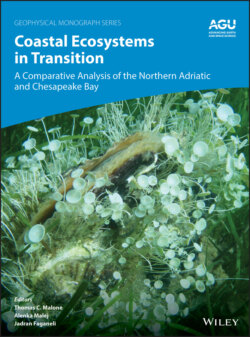Читать книгу Coastal Ecosystems in Transition - Группа авторов - Страница 26
ABSTRACT
ОглавлениеAnthropogenic inputs of nutrients via river runoff are the primary drivers of ecosystem degradation in Chesapeake Bay (CB) and the northern Adriatic Sea (NAS). The annual cycle of river flow is typically unimodal in CB (seasonal peak during spring) and bimodal in the NAS (peaks during April–June and October–December). Dissolved inorganic nitrogen accounts for most of the total nitrogen (TN) in both systems. During 1985–2015, annual loads of TN to CB tended to decrease while total phosphorus (TP) loads tended to increase. In contrast, annual loads of TN to the NAS tended to increase while TP loads tended to decrease. However, these annual input trends were significant only for dissolved inorganic P in the NAS, whereas in the case of N they were masked by interannual changes of the runoff. Climate‐driven changes in the water cycle may bring new challenges of controlling nutrient loading in CB, where annual rainfall is expected to increase. In contrast, annual rainfall is projected to decrease in the NAS region, which would aid efforts to control nutrients. An additional challenge unique to CB is the filling up of Conowingo Reservoir on the Susquehanna River, which resulted in increased P and sediment loads due to reduced trapping efficiency.
